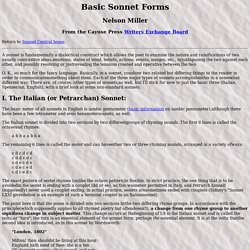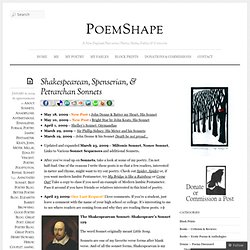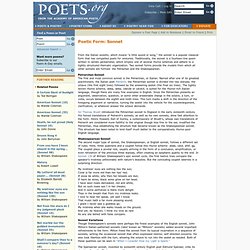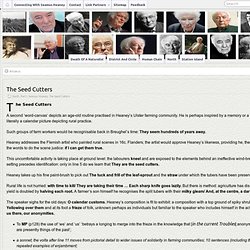

Basic Sonnet Forms. Nelson Miller From the Cayuse Press Writers Exchange Board Return to Sonnet Central home.

A sonnet is fundamentally a dialectical construct which allows the poet to examine the nature and ramifications of two usually contrastive ideas,emotions, states of mind, beliefs, actions, events, images, etc., byjuxtaposing the two against each other, and possibly resolving or justrevealing the tensions created and operative between the two. O. K., so much for the fancy language. I. The basic meter of all sonnets in English is iambic pentameter (basic information on iambic pentameter),although there have been a few tetrameter and even hexametersonnets, as well. The Italian sonnet is divided into two sections by two differentgroups of rhyming sounds.
A b b a a b b a The remaining 6 lines is called the sestet and can haveeither two or three rhyming sounds, arranged in a variety ofways: c d c d c dc d d c d cc d e c d ec d e c e dc d c e d c "London, 1802"Milton! II. A b a b b c b c c d c d e e III. IV. V. Elizabeth Barrett Browning poems: Sonnets from the Portuguese. Shakespearean, Spenserian, & Petrarchan Sonnets « PoemShape. Updated and expanded March 25, 2009 – Miltonic Sonnet, Nonce Sonnet, Links to Various Sonnet Sequences and additional Sonnets.After you’ve read up on Sonnets, take a look at some of my poetry.

I’m not half-bad. One of the reasons I write these posts is so that a few readers, interested in meter and rhyme, might want to try out poetry. Check out Spider, Spider or, if you want modern Iambic Pentameter, try My Bridge is like a Rainbow or Come Out!
Sonnets and Short Poems of Gerard Manley Hopkins, audio recordings by Walter Rufus Eagles. Á la Maison ❧ un sonnet délicieux « PoemShape. Sonnet. From the Italian sonetto, which means "a little sound or song," the sonnet is a popular classical form that has compelled poets for centuries.

Traditionally, the sonnet is a fourteen-line poem written in iambic pentameter, which employ one of several rhyme schemes and adhere to a tightly structured thematic organization. About Sonnets. The Seed Cutters - Connecting with Seamus Heaney. The Seed Cutters A second ‘word-canvas’ depicts an age-old routine practised in Heaney’s Ulster farming community.

He is perhaps inspired by a memory or a photo, even literally a calendar picture depicting rural practice. Such groups of farm workers would be recognisable back in Breughel’s time: They seem hundreds of years away. Heaney addresses the Flemish artist who painted rural scenes in 16c. Flanders; the artist would approve Heaney’s likeness, providing he, the poet, can find the words to do the scene justice: if I can get them true. This uncomfortable activity is taking place at ground level: the labourers kneel and are exposed to the elements behind an ineffective wind-break. Poetry Form - The Sonnet. The Sonnet Verse Formby J.

Zimmerman Do you have a passion to express, an argument to press? As in "All's fair in love and war", the Sonnet may be the form you need, whether to convince the one you love or to convince the world. The name Sonnet came (through the French) from the Italian sonnetto ("little sound" or "little song"). History. Sonnets - English: Texts Over Time (ENG1TOT) Free Sound Effects - SoundGator.
Listening to Poetry: Sounds of the Sonnet. Favorite Poem Project. Listening to Poetry: Sounds of the Sonnet. Discovering Traditional Sonnet Forms. Overview Featured Resources From Theory to Practice In this lesson, students read and analyze sonnets to discover their traditional forms.

Students chart the poems’ characteristics, including the poetic features and their emotional responses to the poems. They then review the details for similarities, deducing traditional sonnet forms that the poems have in common. Back to top Traditional Sonnets for Analysis: This page features links to the text of traditional sonnets. Interactive Sonnet Characteristics Chart: Using this online tool, students enter information about sonnets they are analyzing, including the number of lines and stanzas, lines per stanza, rhyme scheme, meter, and other observations.
Albert Somers, author of Teaching Poetry in High School, asserts that the "business of structure seems to be the poetry teacher's greatest bugaboo" (145). Traditional Sonnets for Analysis.